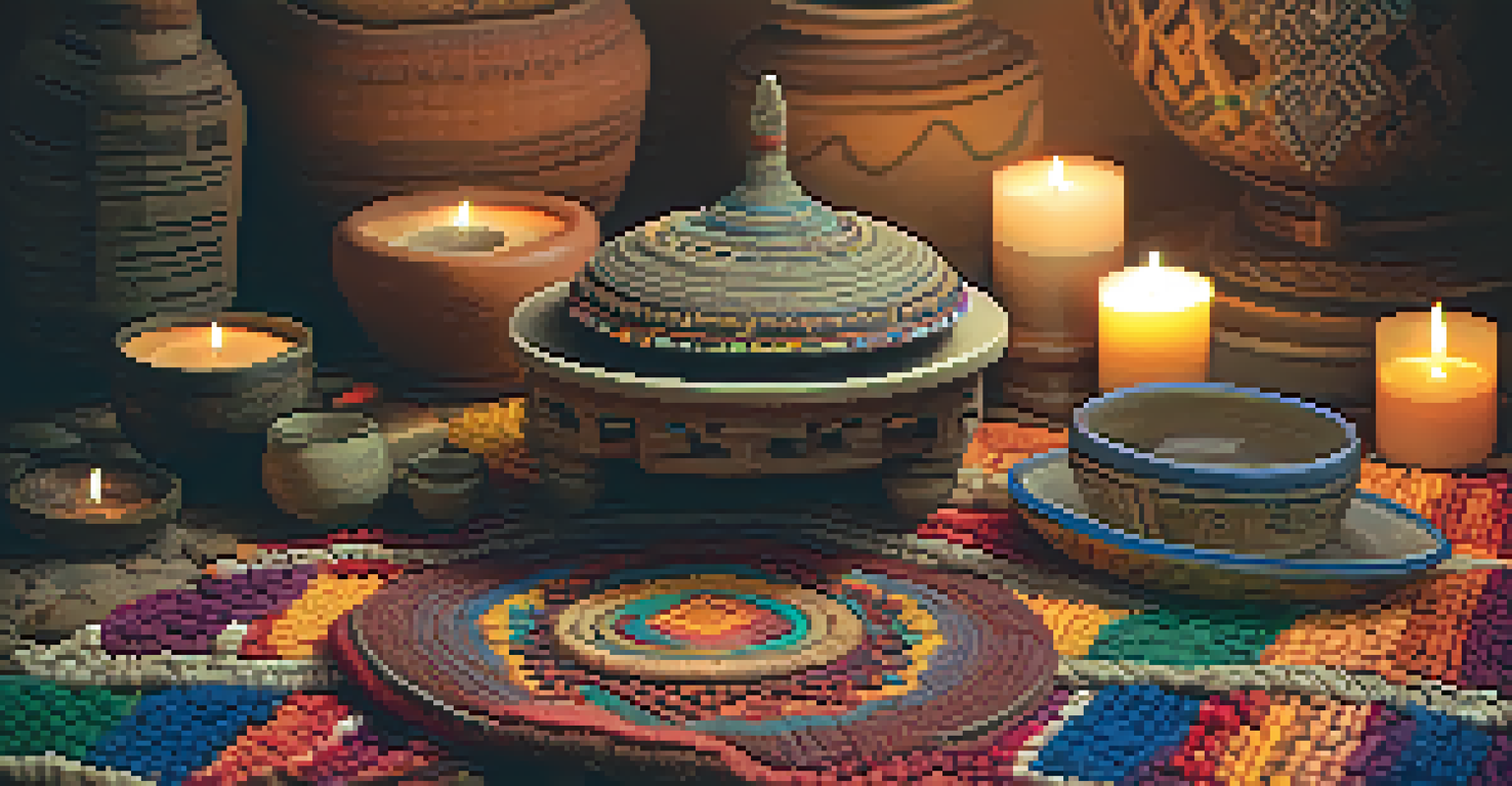Comparative Analysis of Entheogens and Mystical Traditions

Understanding Entheogens: Definitions and Origins
Entheogens are substances that can induce altered states of consciousness, often used in spiritual or religious contexts. The term itself comes from Greek roots meaning 'generating the divine within.' Historically, cultures around the world have utilized these substances in rituals to connect with the divine, seek guidance, or enhance spiritual experiences. Common examples include psilocybin mushrooms, peyote, and ayahuasca, each with rich traditions and cultural significance.
The use of entheogens is not merely recreational; it's deeply embedded in the mystical traditions of various cultures.
These substances often contain psychoactive compounds that can lead to profound experiences, altering perception, emotion, and cognition. This transformation can facilitate deep introspection, encourage a sense of unity with nature, or evoke feelings of transcendence. Such experiences can be deeply personal and vary widely from person to person, depending on factors like setting and mindset.
The use of entheogens is not merely recreational; it's deeply embedded in the mystical traditions of various cultures. From the shamanic rituals of Indigenous peoples to the spiritual practices of modern-day seekers, these substances are viewed as tools for navigating the complexities of the human experience and connecting with something greater than oneself.
Mystical Traditions: An Overview
Mystical traditions encompass a range of practices aimed at achieving a direct experience of the divine or ultimate reality. These can be found in various religions, including Christianity, Buddhism, Sufism, and Hinduism, each offering unique paths to spiritual understanding. Practices such as meditation, prayer, and contemplation are common, guiding practitioners toward a deeper connection with the sacred.

Within these traditions, the concept of 'mysticism' often implies a journey inward, where individuals seek to transcend the ordinary and touch the extraordinary. This journey can involve various techniques, such as breath control, chanting, or even fasting, each designed to quiet the mind and open the heart. The goal is often a profound experience of unity, love, or enlightenment.
Entheogens Foster Spiritual Connection
Entheogens are used in various cultures as sacred tools to induce altered states of consciousness for spiritual growth and connection.
While mystical experiences can occur spontaneously, many traditions provide structured pathways to facilitate these encounters. This structured approach can create a supportive environment for individuals to explore their spirituality, often leading to transformative insights and a deeper understanding of themselves and their place in the universe.
Historical Context: Entheogens in Ancient Mysticism
Throughout history, various cultures have employed entheogens within their mystical practices. For instance, ancient Greeks used kykeon, a drink possibly containing psychoactive elements, during the Eleusinian Mysteries to seek divine knowledge. Similarly, the indigenous peoples of the Americas have long used peyote and other plant medicines in sacred ceremonies aimed at connecting with the spiritual realm.
Ultimately, both paths can coexist and complement one another, offering individuals a spectrum of options in their spiritual journeys.
These historical practices illustrate how entheogens have been woven into the fabric of spiritual life across different civilizations. They often serve as catalysts for mystical experiences, providing practitioners with a sense of clarity and insight that can be hard to achieve through traditional means. This historical context enriches our understanding of how these substances were not merely tools, but integral components of a larger spiritual quest.
As we explore these ancient practices, it becomes evident that the use of entheogens is not a modern phenomenon. Instead, it reflects a long-standing human desire to explore consciousness and seek a deeper connection with the divine, highlighting the timeless quest for spiritual understanding.
Contemporary Use of Entheogens in Spiritual Practices
In recent years, there has been a resurgence of interest in entheogens, particularly within contemporary spiritual communities. Many individuals are turning to substances like ayahuasca and psilocybin for personal growth and healing, often viewing them as modern-day sacraments. This shift reflects a broader societal movement toward exploring alternative spiritual practices beyond traditional religious frameworks.
Retreats and ceremonies centered around these substances have become increasingly popular, attracting participants seeking transformative experiences. These gatherings often emphasize set and setting, ensuring that individuals are in a supportive environment conducive to introspection and healing. Facilitators, often experienced guides, help navigate the journey, ensuring safety and integration of the experience afterwards.
Mysticism Offers Diverse Pathways
Mystical traditions provide structured practices like meditation and prayer to achieve a direct experience of the divine.
As more people share their stories of healing and insight, the stigma surrounding entheogens is gradually dissipating. This growing acceptance is fostering conversations about their potential role in mental health, spiritual well-being, and personal transformation, bridging the gap between ancient practices and modern spiritual exploration.
Comparing Experiences: Entheogens vs. Mystical Practices
While entheogens and traditional mystical practices both aim for spiritual connection, the experiences they offer can differ markedly. Entheogens often induce intense, altered states of consciousness that can lead to vivid visual and emotional experiences, whereas mystical practices like meditation may cultivate a more gradual sense of peace and insight. Each approach has its unique benefits and challenges, catering to different spiritual seekers.
For some, the immediate and profound effects of entheogens can offer a shortcut to spiritual awakening, providing insights that might take years of meditation to achieve. However, this intensity can also be overwhelming, leading to challenging experiences that require careful integration. On the other hand, traditional mystical practices may foster a deeper, more sustained connection to spirituality but can demand considerable time and dedication.
Ultimately, both paths can coexist and complement one another, offering individuals a spectrum of options in their spiritual journeys. Whether one chooses the immediacy of entheogenic experiences or the gradual unfolding of wisdom through mystical practices, the goal remains the same: to bridge the gap between the self and the divine.
Cultural Perspectives: Entheogens and Mystical Traditions
Cultural contexts play a significant role in shaping how entheogens are perceived and used. In many Indigenous cultures, these substances are revered as sacred tools, integral to rituals and community bonding. This contrasts starkly with the often stigmatized views in Western societies, where entheogens may be seen primarily as recreational drugs, disconnected from their spiritual origins.
When exploring different cultural perspectives, it becomes clear that understanding the context is crucial for appreciating the role of entheogens in spiritual practices. For instance, the use of ayahuasca in the Amazon is steeped in centuries of tradition, where it's viewed as a means to connect with ancestors and the spirit world. In contrast, Western approaches may lack this cultural framework, leading to misunderstandings about the purpose and potential of these substances.
Integration of Old and New Practices
The future of spirituality may involve blending ancient entheogenic practices with modern therapeutic insights, creating innovative spiritual experiences.
By examining these cultural narratives, we can foster a more nuanced understanding of how entheogens and mystical traditions intersect. This awareness can encourage respect for Indigenous practices while promoting a more informed dialogue about the spiritual dimensions of entheogens in modern contexts.
Future Directions: Integrating Entheogens and Mysticism
The conversation surrounding entheogens and mystical traditions is evolving, with increasing interest in how these elements can inform one another. As research into the therapeutic potential of entheogens continues to grow, there's an opportunity to integrate these insights into more traditional spiritual practices. This integration could lead to new forms of spiritual exploration that honor both ancient wisdom and modern scientific understanding.
Moreover, as more people experience the benefits of entheogens, there is potential for greater acceptance and understanding within mainstream spirituality. This could pave the way for innovative practices that blend the immediacy of entheogenic experiences with the depth of traditional mystical approaches. Such hybrids could attract a diverse audience, bridging gaps between varying spiritual paths.

Ultimately, the future holds exciting possibilities for integrating entheogens and mystical traditions. By fostering open dialogue and mutual respect, we can create enriching spaces for exploration and understanding, encouraging individuals to embark on their own journeys toward spiritual awakening and connection.